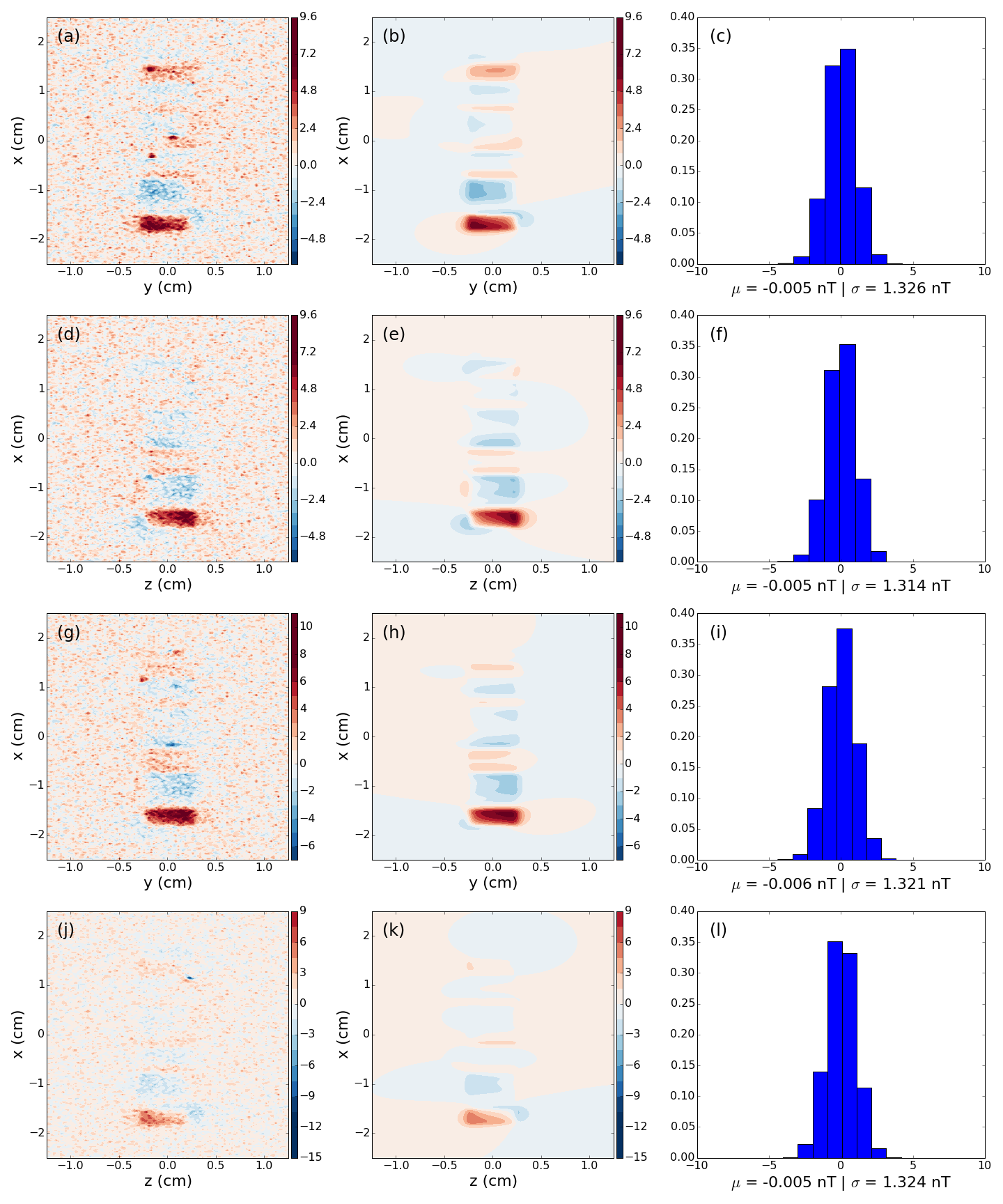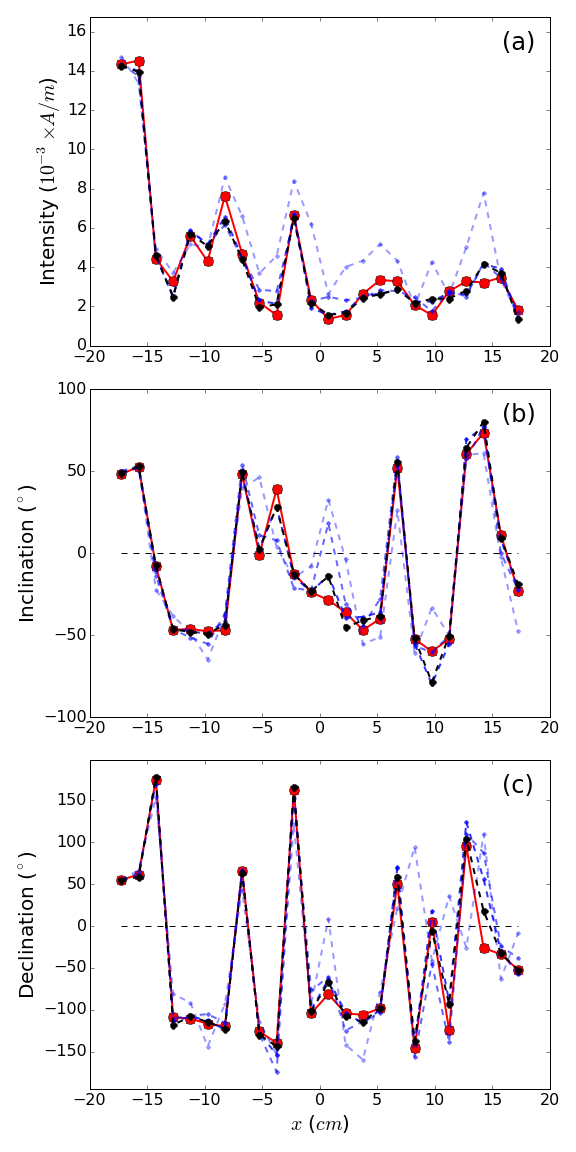by A. L. A. Reis1, V. C. Oliveira Jr.1, E. Yokoyama2, A. C. Bruno3, and Pereira, J. M. B.3
1Department of Geophysics, Observatório Nacional, Rio de Janeiro, RJ, Brazil.
2Institute of Geosciences, University of Brasília, Brasília, DF, Brazil.
3Department of Physics, Pontifical Catholic University of Rio de Janeiro, Rio de Janeiro, RJ, Brazil.
This paper has been published in Geochemistry, Geophysics, Geosystems (G3).
doi: 10.1002/2016GC006329
A PDF version is available at www.pinga-lab.org/papers/paper-magnetization-rock-sample-2016.html
Over the last decades, scanning magnetic microscopy techniques have been increasingly used in paleomagnetism and rock magnetism. Different from standard paleomagnetic magnetometers, scanning magnetic microscopes produce high-resolution maps of the vertical component of the magnetic induction field (flux density) on a plane located over the sample. These high-resolution magnetic maps can be used for estimating the magnetization distribution within a rock sample by inversion. Previous studies have estimated the magnetization distribution within rock samples by inverting the magnetic data measured on a single plane above the sample. Here we present a new spatial domain method for inverting the magnetic induction measured on four planes around the sample in order to retrieve its internal magnetization distribution. We have presumed that the internal magnetization distribution of the sample varies along one of its axes. Our method approximates the sample geometry by an interpretation model composed of a one-dimensional array of juxtaposed rectangular prisms with uniform magnetization. The Cartesian components of the magnetization vector within each rectangular prism are the parameters to be estimated by solving a linear inverse problem. Our method automatically deals with the averaging of the measured magnetic data due to the finite size of the magnetic sensor, preventing the application of a deconvolution before the inversion. Tests with synthetic data show the performance of our method in retrieving complex magnetization distributions even in the presence of magnetization heterogeneities. Moreover, they show the advantage of inverting the magnetic data on four planes around the sample adn how this new acquisition scheme improves the estimated magnetization distribution within the rock sample. We have also applied our method to invert experimentally measured magnetic data produced by a highly-magnetized synthetic sample that was manufactured in the laboratory. The results show that, even in the presence of apparent position noise, our method was able to retrieve the magnetization distribution consistent with the isothermal remanent magnetization induced in the sample.
(a), (d), (g) and (j) Noise-corrupted magnetic data produced by a synthetic marine ferro-manganese crust sample (not shown) on the observation four observation planes, respectively. (b), (e), (h), (k) Predicted data produced by the estimated magnetization distribution obtained by inversion on the four observation planes, respectively. The estimated magnetization distribution was obtained by inverting the magnetic data located on the four observation planes. The color scales are slightly saturated for improving the visualization. (c), (f), (i) and (l) Normalized histograms of the residuals between the predicted data shown in (b), (e), (h), (k) and the noise-corrupted magnetic data shown in (a), (d), (g), (j). The values are in nT.
Comparison between the true (red dots) and estimated (blue and black dots) magnetization (a) intensity, (b) inclination and (c) declination.
You can download a copy of all the files in this repository by cloning the git repository:
git clone https://github.com/pinga-lab/magnetization-rock-sample.git
or click here to download a zip archive.
All source code used to generate the results and figures in the paper are in
the code folder.
The data used in this study is provided in data and the sources for the
manuscript text and figures are in manuscript.
See the README.md files in each directory for a full description.
The calculations and figure generation are all run inside Jupyter notebooks. You can view a static (non-executable) version of the notebooks in the nbviewer webservice:
http:https://nbviewer.jupyter.org/github/pinga-lab/magnetization-rock-sample
See sections below for instructions on executing the code.
You'll need a working Python 2.7 environment with all the standard scientific packages installed (numpy, scipy, matplotlib, etc). The easiest (and recommended) way to get this is to download and install the Anaconda Python distribution. Make sure you get the Python 2.7 version.
You'll also need to install the Fatiando a Terra library from GitHub. We used a development version defined by the commit hash 09cd37da986114a68c57c6a611271fc6cd22bde4. See the install instructions on the website.
To execute the code in the Jupyter notebooks, you must first start the notebook server by going into the repository folder and running:
jupyter notebook
This will start the server and open your default web browser to the Jupyter
interface. In the page, go into the code folder and select the
notebook that you wish to view/run.
The notebook is divided cells (some have text while other have code).
Each cell can be executed using Shift + Enter.
Executing text cells does nothing and executing code cells runs the code
and produces it's output.
To execute the whole notebook, run all cells in order.
All source code is made available under a BSD 3-clause
license. You can freely
use and modify the code, without warranty, so long as you provide attribution
to the authors. See LICENSE.md for the full license text.
The manuscript text is not open source. The authors reserve the rights to the article content, which is published in Geochemistry, Geophysics, Geosystems (G3).

